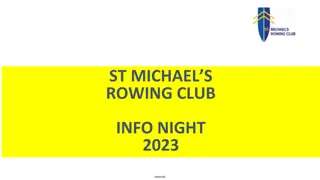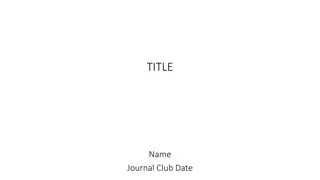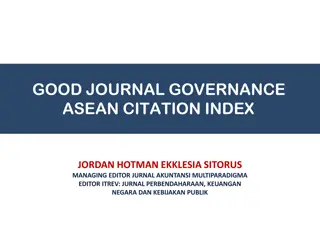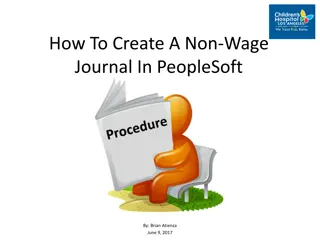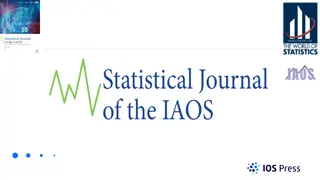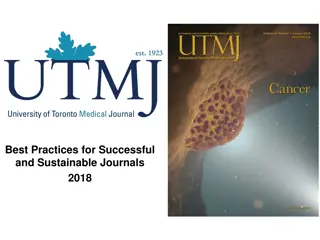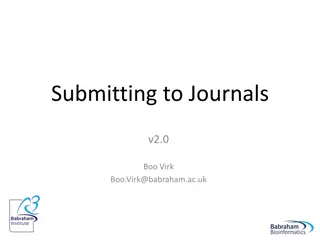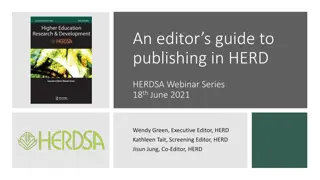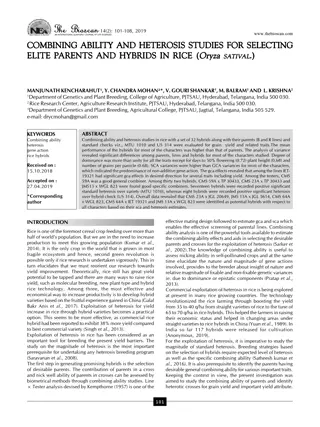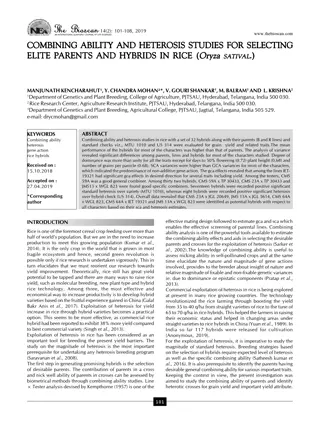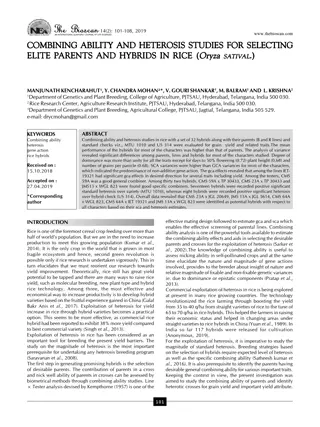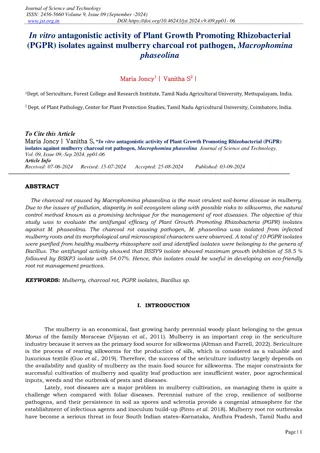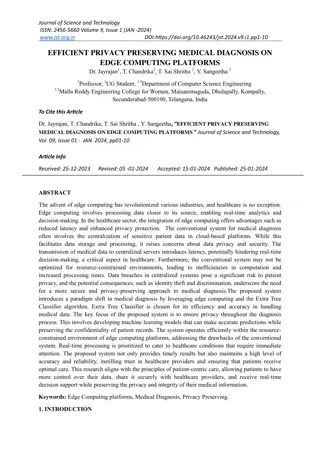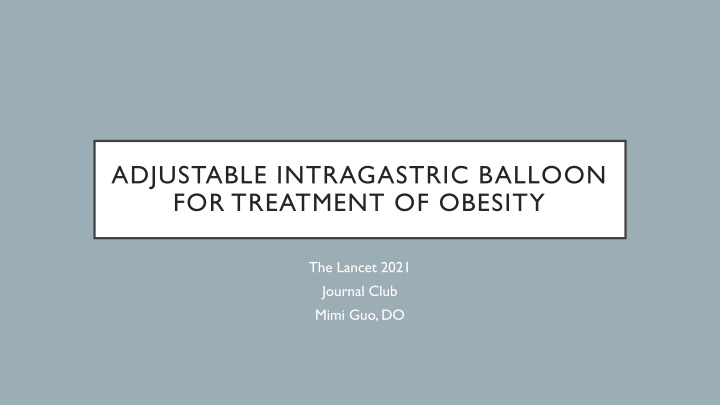
Adjustable Intragastric Balloon for Obesity Treatment Study
Explore the safety, efficacy, and utility of an adjustable intragastric balloon (aIGB) as an adjunct therapy for patients with class I and II obesity. This study involves a prospective, non-blinded, multicenter trial with 288 participants randomly assigned to receive aIGB along with dietary and exercise counseling or counseling alone. The study design includes adjustments in balloon volume based on patient characteristics and offers insights into weight loss outcomes at 32 weeks and beyond.
Uploaded on | 1 Views
Download Presentation

Please find below an Image/Link to download the presentation.
The content on the website is provided AS IS for your information and personal use only. It may not be sold, licensed, or shared on other websites without obtaining consent from the author. If you encounter any issues during the download, it is possible that the publisher has removed the file from their server.
You are allowed to download the files provided on this website for personal or commercial use, subject to the condition that they are used lawfully. All files are the property of their respective owners.
The content on the website is provided AS IS for your information and personal use only. It may not be sold, licensed, or shared on other websites without obtaining consent from the author.
E N D
Presentation Transcript
ADJUSTABLE INTRAGASTRIC BALLOON FOR TREATMENT OF OBESITY The Lancet 2021 Journal Club Mimi Guo, DO
RELEVANCE New & Current Tx Therapies: Amylin analogues e.g.Cagrilintide GLP-1 agonists e.g.Semaglutide Orlistat, naltrexone-bupropion, phentermine-topiramate Bariatric surgery (BMI >/= 35, Obesity-related comorbidity)
QUESTION What is the safety profile, efficacy and utility of aIGB as an adjunct therapy for patients with class I and II obesity? Unique in that volume can be augmented according to therapy goals or side effects Class I BMI of 30 to <35 Class II BMI of 35 to <40
STUDY DESIGN Prospective, non-blinded, multicenter study (7 Sites in the U.S.) 288 Patients (n= 187 Case, n= 101 Control) Randomly assigned to receive: aIGB + dietary, exercise counselling Vs. Dietary & exercise counselling alone 32 Wk Study w/ follow-up 24 wks post study period 1,000- 1,200 kcal/day diet
STUDY DESIGN CONT. Day 0: Endoscopically implanted Initial Volumes: 400mL, 450mL, 500mL or 550mL based on patient height & hx of GERD End of 2 Wks: Increased by 250mL if no treatment effect or decreased by 100- 150mL (Min. volume of 300 mL) to reduce SEs Wk 18 (+/- 4 Wks): Could increase volume to max. Of 1,000mL
INCLUSION CRITERIA Ages 22- 65 years old BMI 30- 40 kg/m2 w/ BMI of at least 30 kg/m2 for 2 preceding years Previous unsuccessful trials of non-surgical weight loss methods Willing to comply w/ dietary restrictions
MEASURED OUTCOMES Mean % of total bodyweight loss at 32 wks Total bodyweight loss= ((Day 0 weight-Weight at balloon extraction)/ Day 0 weight) x100 Short-term weight loss maintenance of 40% (6 Mo post balloon removal) = (Day 0 weight-Weight @ 6 mo post removal)/(Day 0 weight-Weight on removal visit)
ANALYSES Primary analyses was done on intention-to-treat population; Excluded patients who had contraindications to aIGB placement on initial EGD ITT analyses was done on multiple-imputed dataset of blinded weights at 32 wks
RESULTS ITT aIGB group had a 15% [95% CI 13.9-16.1] total bodyweight lossVs. Control group had a 3.3% [2- 4.6] p <0.0001 Difference in mean % of total bodyweight loss b/t the 2 groups 11.7% [9.9- 13.5] 40% Weight loss maintenance was achieved in 107 (74%) patients in the aIGB group at 6 mo f/u Weight loss in aIGB group ranged from 0kg- 34kg Vs. 7kg- 23kg in control group
TAKE-AWAYS Adjustable intragastric balloons may offer a less invasive and anatomy- preserving therapy for weight loss Favorable safety profile without long-term consequences More individualized approach;Improve SE tolerability and prevent early removal of balloons
STRENGTHS & LIMITATIONS Strengths Multi-center study Randomized clinical trial Longitudinal follow-up period Limitations No blinding Study cohort included higher proportion of women Not powered to investigate improvement in obesity-related comorbidities
REFERENCES Abu Dayyeh, B. K., Maselli, D. B., Rapaka, B., Lavin, T., Noar, M., Hussan, H., Chapman, C. G., Popov, V., Jirapinyo, P., Acosta, A., Vargas, E. J., Storm, A. C., Bazerbachi, F., Ryou, M., French, M., Noria, S., Molina, D., & Thompson, C. C. (2021). Adjustable intragastric balloon for treatment of obesity: A Multicentre, open-label, Randomised Clinical Trial. The Lancet, 398(10315), 1965 1973. https://doi.org/10.1016/s0140-6736(21)02394-1 https://www.cdc.gov/obesity/adult/defining.html

